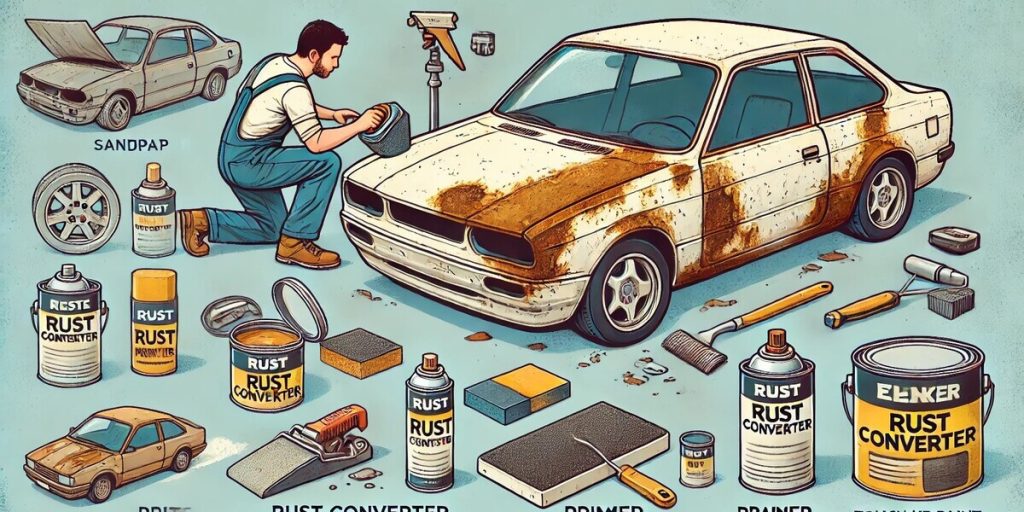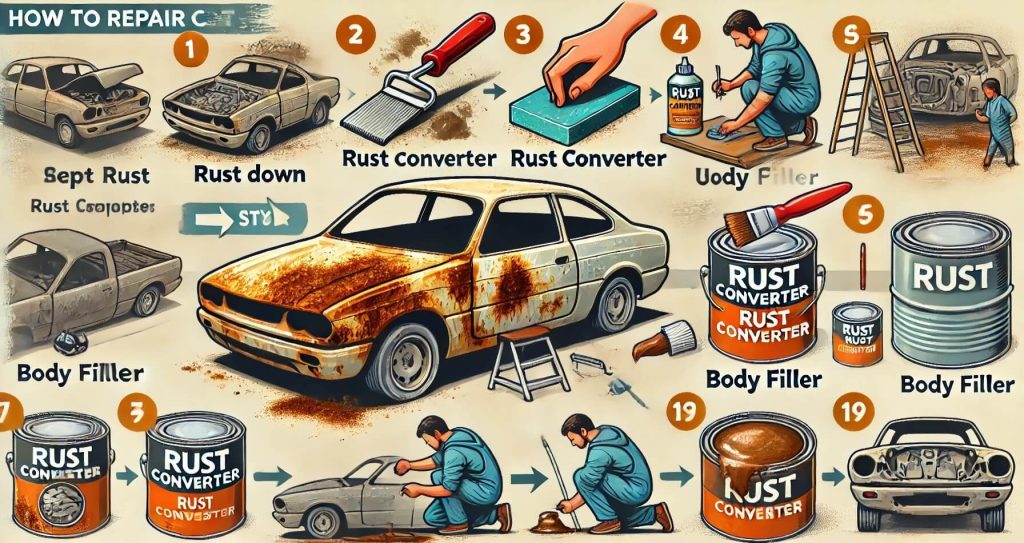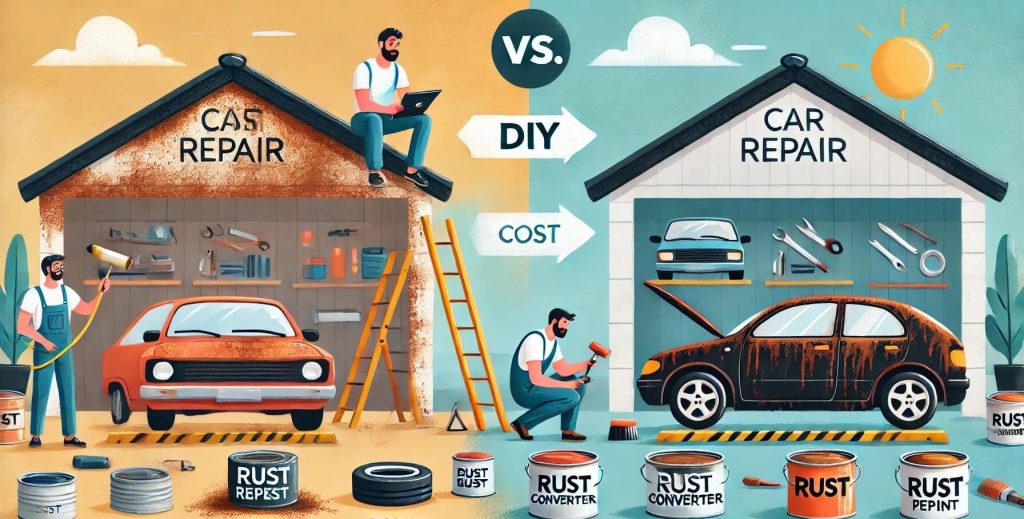Last Updated on February 17, 2025 by Mark S. Taylor
Car rust is like a silent thief—it sneaks up on you and slowly eats away at your car’s body. I learned this the hard way when I spotted a tiny rust spot on my fender, only to find it had spread underneath like an iceberg. Knowing how to repair car rust isn’t just about looks; it’s about keeping your ride safe and on the road longer. Whether you’re dealing with small rust spots or gaping holes, I’ll walk you through the best ways to fix it—no guesswork, just real solutions that work. Let’s dive in and save your car from the rust monster!

Rust is like a bad cold for your car—it starts small, but if you ignore it, things get ugly fast. Ever noticed a little orange spot on your fender and thought, “Eh, no big deal”? That’s how I felt until I found a hole in my rocker panel. Car rust happens when metal meets moisture and oxygen, creating corrosion that slowly eats away at your vehicle.
There are three main types of rust: surface rust, scale rust, and penetrating rust. Surface rust is just on the paint—easy fix. Scale rust digs into the metal, needing more work. But penetrating rust? That’s when things get serious, with holes forming in the body or frame. The key to saving your car (and your wallet) is catching rust early and choosing the right fix before it spreads.
Contents
Tools & Materials Needed for Car Rust Repair: What You’ll Need to Get the Job Done
So, you’re ready to tackle that rust problem head-on? Awesome! But before you dive in, let’s talk tools and materials. Think of this like prepping for a DIY home improvement project—you wouldn’t try to fix a leaky faucet without a wrench, right? The same goes for rust repair. Having the right gear makes all the difference. Short answer: Essential tools include sandpaper, rust converter, primer, paint, body filler, and a rust repair kit.
When I first started repairing rust, I underestimated how much prep work was involved. I thought, “How hard can it be?” Turns out, it’s not rocket science, but it does require the right tools. Sandpaper is your best friend for removing rust and smoothing surfaces. A rust converter acts like a magic potion, neutralizing rust so it doesn’t spread. Then, you’ll need primer and paint to seal the deal and make everything look fresh again. For bigger jobs, body filler or a car rust repair kit can save the day. Short answer: Use sandpaper to remove rust, a converter to stop it, and primer/paint to finish the job.
Now, here’s where it gets interesting: you’ve got options. If you’re handy and love a good DIY challenge, grabbing a rust repair kit from the auto store is a solid choice. These kits usually come with everything you need—patches, adhesives, and even instructions. But if the rust is more than skin-deep (like holes or structural damage), it might be worth calling in the pros. Trust me, there’s no shame in knowing your limits. I once tried to fix a massive hole in my floor pan myself, only to realize I needed welding skills I just didn’t have. Sometimes, professional help is the smarter move. Short answer: DIY kits work for small repairs; hire a pro for major structural rust issues.

Step-by-Step Guide: How to Repair Car Rust (Let’s Fix This Together!)
Alright, let’s roll up our sleeves and get to work. Rust repair might sound intimidating, but I promise—it’s easier than you think if you break it down into manageable steps. Whether you’re dealing with a tiny spot or a gaping hole, I’ll walk you through exactly what to do. Think of this as your personal rust-busting playbook. Ready? Let’s dive in.
1. How to Fix Small Rust Spots on a Car
Small rust spots are like weeds in your garden—if you catch them early, they’re easy to deal with. Start by sanding the area with coarse-grit sandpaper to remove all the rust. Once it’s smooth, apply a rust converter to neutralize any remaining corrosion. Finish by priming and painting the area to seal it off. Short answer: Sand, treat with rust converter, then prime and paint for small rust spots.
I remember my first small rust spot—it felt like a disaster at the time. But after grabbing some sandpaper and a $10 rust converter from the auto store, I had it looking good as new in under an hour. It’s amazing how much difference a little effort can make.
2. How to Fix Rust Bubbles on Car Paint
Rust bubbles are sneaky—they look harmless but can hide deeper damage underneath. Start by carefully sanding the bubbled area to see how bad it really is. If it’s just surface rust, treat it with a rust converter and repaint. But if the metal feels weak or crumbly, you’ve got a bigger problem on your hands. Short answer: Sand to assess damage; treat surface rust or seek help for deeper issues.
Here’s a tip: blending new paint with the old is key to making the repair invisible. I once spent hours perfecting the color match on my car door, and the result was so seamless, even my mechanic couldn’t tell where I’d fixed it. Patience pays off!
3. How to Fix Rust Holes on a Car (With & Without Welding)
A. Rust Hole Repair Without Welding
For smaller holes, you don’t need welding skills—fiberglass filler or body filler will do the trick. Clean the area thoroughly, apply the filler, and let it cure. Then, add a rust-proof coating and repaint. Short answer: Use fiberglass or body filler for small holes, then coat and paint.
When I patched a hole in my trunk with fiberglass filler, I was shocked at how sturdy it felt afterward. It’s not glamorous, but it gets the job done without breaking the bank.
B. Fixing Large Rust Holes in a Car (Welding Method)
Big holes? That’s where welding comes in. Cut out the rusted section, weld in a new metal patch, and seal everything with primer and paint. If welding isn’t your thing, this is where a pro can save the day. Short answer: Cut, weld, and seal for large holes—or hire a professional.
I’ll admit, welding intimidated me at first. So, I took a class—it was worth every penny. Now, I feel confident tackling even the toughest rust jobs.
4. How to Repair Rusted Car Panels, Doors, and Floor Pans
Rusted panels and floor pans are no joke—they can compromise your car’s safety. For minor rust, sand, treat, and patch. But if the damage is severe, replacing the panel or floor pan might be necessary. Short answer: Sand and patch minor rust; replace panels or pans for major damage.
Once, I discovered rust eating away at my car’s rocker panel. After removing the damaged section and installing a patch, I felt like a superhero. It’s messy work, but the sense of accomplishment is unmatched.
5. How to Repair Rust Under the Car (Frame, Chassis, and Rocker Panels)
Rust under the car is like a hidden enemy—it’s out of sight but can cause serious structural damage. Inspect regularly, especially if you live in a snowy or coastal area. Use rust-neutralizing sprays to stop corrosion in its tracks, and repair rusted rocker panels or frame sections as needed. Short answer: Inspect, neutralize with sprays, and repair structural rust promptly.
Living near the beach taught me to check under my car every few months. A quick spray with a rust inhibitor saved me from costly repairs more times than I can count.
6. Preventing Rust from Spreading on a Car
Prevention is your best defense against rust. Use rust-proofing sprays on vulnerable areas like wheel wells and bumpers. Wash your car regularly, especially after driving on salted roads. And fix small rust spots before they grow into bigger problems. Short answer: Use rust-proofing products, wash regularly, and fix small rust early.
One winter, I skipped washing my car for weeks because it was freezing outside. Big mistake. By spring, I had rust spots everywhere. Now, I make it a habit to wash and protect my car, no matter the weather.

Cost of Car Rust Repair: DIY vs. Professional (What’s Right for You?)
Rust repair costs can range from a quick DIY fix to a pricey professional job. I remember the first time I got a quote for a rust repair—it was nearly $1,000 for a few rust spots! That’s when I decided to learn how to repair car rust myself. DIY rust repair can cost as little as $30–$100 for sandpaper, rust converter, primer, and paint. If you need body filler for a rust hole, expect to spend around $50–$200.
But not all rust jobs are DIY-friendly. If rust has eaten through the car frame or major panels, a professional rust repair can range from $500 to over $3,000, depending on the damage. Welding, panel replacements, and repainting drive up costs. The rule of thumb? Small rust spots and surface rust—fix it yourself. Major structural rust—leave it to the pros. Either way, fixing rust early saves money before it spreads and turns into a bigger headache.
How to remove surface rust from a car?
The easiest way to remove surface rust is by sanding it down, applying a rust converter, and then repainting the area. I once spotted a tiny rust patch on my car’s hood and ignored it—big mistake. Within months, it spread like wildfire. If you catch rust early, a little sanding and touch-up paint can save you a lot of trouble.
What’s the best way to fix car rust damage?
The best method depends on the severity. For small rust spots, sanding and repainting work well. For deeper rust, you may need rust converters, body filler, or even metal patches. I always say, “If you can poke a hole through it, surface fixes won’t cut it.” That’s when you’ll need serious repair work.
Can I use a car rust repair kit for major rust issues?
Car rust repair kits are great for small to medium-sized rust damage, but for large rust holes, a kit alone won’t be enough. I once tried fixing a rusted-out wheel well with just a kit—it looked okay for a while, but within a year, the rust came back worse. For major rust, welding or professional help may be needed.
How long does a rust repair last?
A well-done rust repair can last several years, but it depends on the prep work. If you don’t remove all the rust before painting, it will come back. Proper sanding, rust treatment, and sealing the area with primer and paint are key to long-lasting results.
How do I stop rust from coming back?
Rust prevention is all about maintenance. Regular washing, applying rust-proof coatings, and fixing small chips in the paint can keep rust away. After dealing with rust on my old truck, I now make sure to inspect for rust every few months—it’s easier to stop than to fix!
My Final Thoughts on How to Repair Car Rust
If you love your car and want to keep it running strong, learning how to repair car rust is a skill worth having. DIY rust repair is great if you’re patient and enjoy hands-on work, but for deep rust or structural damage, a professional might be the safer bet. I’ve done both—sometimes a little sanding and paint do the trick, but other times, I’ve had to call in the experts.
The key is catching rust early before it spreads. Whether you go DIY or hire a pro, don’t wait—rust doesn’t take a day off!
